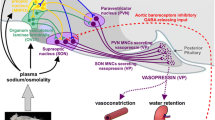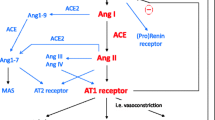Summary
Sodium chloride has no clearly established local direct action on blood vessels to produce constriction; on the contrary, it has an immediate local indirect action via osmolality, which produces vasodilation. Thus in order to explain salt-induced hypertension, a delayed remote indirect vasoconstrictor action must be postulated. This indirect vasoconstrictor action is apparently the result of volume expansion. Acute volume expansion imparts three physiologic properties to the plasma; these are the ability to inhibit Na,K-ATPase and the Na−K pump, to cause natriuresis, and to sensitize blood vessels to vasoconstrictor agents. Similarly, lowrenin, volume-expanded hypertension endows the plasma with the capacity to inhibit the Na,K-ATPase pump, to sensitize blood vessels to vasoconstrictor agents, and to raise blood pressure. These properties apparently result from a circulating digitalislike substance(s), perhaps derived from the hypothalamus and/or adrenals. We here review the considerable effort expended in identifying the agent or agents, and conclude that both steroidal and peptidic structure must be considered. Regardless of its structure, we hypothesize that when sodium excretion does not keep pace with sodium intake, its release leads to increased contractile activity of cardiac and vascular smooth muscle and hence hypertension. Inhibition of the Na−K pump increases the intracellular sodium concentration, particularly when superimposed on genetic- or aldosterone-induced increased sodium permeability, resulting in depolarization and increased calcium influx (vascular smooth muscle) or altered Na+−Ca2+ exchange and decreased calcium efflux (heart muscle). The increased intracellular calcium concentration then accounts for the increased contractile activity. Depolarization may also increase the sensitivity of vascular smooth muscle to vasoconstrictor agents such as norepinephrine. There may also be more norepinephrine in the neuromuscular cleft since norepinephrine uptake into adrenergic nerve terminals decreases with Na,K-ATPase inhibition.
Similar content being viewed by others
References
Haddy FJ. Ionic control of vascular smooth muscle cells.Kidney Int 1988;25:S2-S8.
Haddy FJ, Overbeck HW. The role of humoral agents in volume expanded hypertension.Life Sci 1976;19:953–948.
Blaustein M. Sodium ions, calcium ions, blood pressure regulation and hypertension: A reassessment and a hypothesis.Am J Physiol 1977;232:C165-C173.
Solandt DY, Nassim R, Cowan CR. Hypertensive effect of blood from hypertensive dogs.Lancet 1940;1:873–874.
deWardener HE, Mills IH, Clapham WF, et al. Sudies on the efferent mechanism of the sodium diuresis which follows the administration of intravenous saline in the dog.Clin Sci 1961;21:249–258.
Hinke JAM. In vitro demonstration of vascular hyper-responsiveness in experimental hypertension.Circ Res 1965;17:359–371.
Kramer H, Gonick H, Paul W, et al. Third factor: Inhibitor of Na−K-ATPase? (abstract)Proc 4th Int Congr Nephrol 1969;373.
Pamnani MB, Clough DL, Huot SJ, et al. Sodium-potassium pump activity in experimental hypertension. In: Vanhoutte PM, Leusen I, eds.,Vasodilatation. New York: Raven Press, 1981:391–403.
Pamnani M, Huot S, Steffen R, et al. Evidence for a humoral Na+ transport inhibiting factor(s) in one-kidney, one wrapped hypertensive dogs.Physiologist 1980;23:91.
Pamnani MB, Huot S, Buggy J, et al. Demonstration of a humoral inhibitor of the Na+−K+ pump in some models of experimental hypertension.Hypertension 1981;3(Suppl 2): 96–101.
Gruber KA, Whitaker JM, Buckalew VM Jr. Endogenous digitalis-like substance in plasma of volume-expanded dogs.Nature 1980;287:743–745.
Poston L, Sewell RB, Wilkinson SP, et al. Evidence for a circulating sodium transport inhibitor in essential hypertension.Br Med J 1981;282:847–849.
Hamlyn JM, Ringel R, Schaeffer H, et al. A circulating inhibitor of (Na+ K+) ATPase associated with essential hypertension.Nature (London) 1982;300:650–652.
deWardener HE, MacGregor GA, Clarkson EM, et al. Effect of sodium intake on ability of human plasma to inhibit renal Na+,K+-adenosine triphosphatase in vitro.Lancet 1981;1:411–412.
Hasegawa T, Masugi F, Ogihara T, Kumahara Y. Increase in plasma ouabain-like inhibitor of Na+,K+-ATPase with high sodium intake in patients with essential hypertension.J Clin Hypertens 1987;3:419–429.
Burris JF, Pamnani MB, Huot SJ, et al. Sodium-potassium pump activity in low renin essential hypertension.Clin Res 1982;30:733A.
Pamnani MB, Haddy FJ. Characteristics of hypertensive patients with increased plasma Na+−K+ pump inhibitory activity.Clin Exp Hypertein 1985;A7:755–768.
Edmondson RPS, Thomas RD, Hilton PJ, et al. Abnormal leucocyte composition and sodium transport in essential hypertension.Lancet 1975;1:1003–1005/
Overbeck HW, Pamnani MB, Akera T, et al. Depresed function of a ouabain-sensitive sodium-potassium pump in blood vessels from renal hypertensive dogs.Circ Res 1976; 38(Suppl 2):48–52.
Pamnani MB, Clough DL, Haddy FJ. Altered activity of the sodium-potassium pump in arteries of rats with steroid hypertension.Clin Sci Mol Med 1978;55:41S-43S.
Huot SJ, Pamnani MB, Clough DL, et al. The role of sodium intake, the Na+−K+ pump and a ouabain-like humoral agent in the genesis of reduced renal mass hypertension.Am J Nephrol 1983;3:92–99.
Huot SJ, Pamnani MB, Clough DL, et al. Sodium-potassium pump activity in reduced renal mass hypertension.Hypertension 1983;5(Suppl 1):94–100.
Songu-Mize E, Bealer SL, Caldwell RW. Effect of AV3V lesions on development of DOCA-salt hypertension and vascular Na+-pump activity.Hypertension 1982;4:575–580.
Clough DL, Pamnani MB, Haddy FJ. Decreased myocardial Na, K-ATPase activity in one-kidney, one clip hypertensive rats.Am J Physiol 1983;245:H224-H251.
Clough DL, Pamnani MB, Haddy FJ. Myocardial Na,K-ATPase activity in rats with steroid and spontaneous hypertension.J Hypertens 1984;2:141–147.
Clough DL, Huot SJ, Pamnani MB, et al. Decreased myocardial Na+,K+-ATPase activity in rats with reduced renal mass-saline hypertension.J Hypertens 1985;3:583–589.
Poston L. Endogenous sodium pump inhibitors: A role in essential hypertension.Clin Sci 1987;72:647–655.
Quintanilla AP, Finn M, Weffer MI, et al. Effect of treatment with hydrochlorothiazide on the red cell Na,K-adenosine triphosphatase in men with hypertension.J Lab Clin Med 1987;110:583–587.
Kojima I, Yoshihara S, Ogata E. Involvement of endogenous digitalis-like substance in genesis of deoxycortico-sterone-salt hypertension.Life Sci 1982:30:1775–1781.
deWardener HE, Clarkson EM. Concept of natriuretic hormone.Physiol Rev 1985;65:658–759.
Haupert GT, Sancho Jm. Sodium transport inhibitor in bovine hypothalamus.Proc Natl Acad Sci USA 1979;76: 4658–4660.
Morgan K, Lewis MD, Spurlock G, et al. Characterization and partial purification of the sodium-potassium ATPase inhibitor released from cultured hypothalamic cells.J Biol Chem 1985;260:13595–13600.
Bealer SL, Haywood JR, Gruber KA, et al. Preoptic hypothalamic periventricular lesions reduce natriuresis to volume expansion.Am J Physiol 1983;244:R51-R57.
Deray G, Rieu M, Devynck MA, et al. Evidence for an endogenous digitalis-like factor in the plasma of patients with acromegaly.N Engl J Med 1987;316:575–580.
Jandhyala BS, Ansari AF. Elevation of sodium levels in the cerebral ventricles of anesthetized dogs triggers the release of an inhibitor of ouabain-sensitive sodium, potassium-ATPase into the circulation.Clin Sci 1986;70:103–110.
Takahashi, H, Matsuzawa M, Suga K, et al. Hypothalamic digitialis-like substance is released with sodium-loading in rats.Am J Hypertens 1988;1:146–151.
Jandhyala BS, Lokhandwala MF, Kivlign SD, et al. Intracisternal administration of pergolide, a dopamine receptor agonist, triggers the release of an inhibitor of ouabrain-sensitive sodium, potassium-dependent adenosine triphosphatase and enhances vascular reactivity in anesthetized dogs.Clin Sci 1987;79:183–188.
Buckley JP, Doursout M-F, Liang Y-Y, et al. Central angiotensin II mechanisms and the sodium pump.J Hypertens 1986;4:S465-S467.
Halperin JA, Shaeffer R, Galvez L, et al. Ouabain-like activity in human cerebrospinal fluid.Proc Natl Acad Sci USA 1983;80:6101–6104.
Halperin JA, Martin MM, Malave S. Increased digitalis-like activity in human cerebrospinal fluid after expansion of the extracellular fluid volume.Life Sci 1985;37:561–566.
Halperin JA, Riordan JF, Tostenson DC. Characteristics of an inhibitor of the Na/K pump in human cerebrospinal fluid.J Biol Chem 1988;263:636–651.
Lichstein D, Minc D, Bourrit A, et al. Evidence for the presence of “ouabain like” compound in human cerebrospinal fluid.Brain Res 1985;325:13–19.
Takahashi H, Matsuzawa M, Nishimura M, et al. Plasma and hypothalamic digoxin-like immunoreactivity and the adrenal glands in rats.Am J Hypertens 1988;1:53A.
Ihara N, Yuri K, Yamada H, et al. Immunohistochemical studies in the distribution of endogenous digitalis-like substance (EDLS)-containing neurons in the rat hypothalamus, with special consideration on the possibility of their coexistence with posterior lobe hormones.Arch Histol Cytol 1988;51:35–42.
LaBella FS, Bihler I, Templeton J, et al. Progesterone derivatives that bind to the digitalis receptor: Effects on Na+,K+-ATPase and isolated tissues.Fed Proc 1985; 44:2806–2811.
Weiland J, Schwabe K, Hübler D, et al. Glycosidation of chlormadinol acetate alters its actions on Na+/K+-transporting ATPase and cardiac contractility: A contribution to the endogenous digitalis problem.J Enzym Inhib 1987;2:31–36.
Lichstein D, Kachalsky S, Deutsch J. Identification of a oua-bain-like compound in toad skin and plasma as a bufodienolide derivative.Life Sci 1986;38:1261–1270.
Tal MD, Katchalsky S, Lichstein D, et al. Exdogenous “oua-bian-like” activity in bovine plasma.Biochem Biophys Res Comm 1986;135:1–8/
Haddy FJ, Pamnani MB, Eliades DC, et al. Effects of bufalin, a Na+,K+-ATPase inhibitor, on cardiovascular hemodynamics and renal water and sodium excretion in dogs and rats.Physiologist 1988;31:A71.
Hamlyn JM, Harris DW, Ludens JH. Purification and characterization of a digitalis-like factor from human plasma.Hypertension 1988;12:336.
Cloix JF, Crabos M, Warner IW, et al. High yield purification of a urinary Na+-pump inhibitor.Biochem Biophys Res Commun 1985;131:1234–1240.
Goto A, Yamada K, Ishii M, et al. The effects of urinary digitalislike factor on cultured vascular smooth muscle cells.Hypertension 1988;11:645–650.
Goto A, Yamada K, Yoshioka M, et al. Effects of human urine-derived digitalis-like factor on cultured renal tubular epithelial cells.Abstracts, 12th scientific meeting of the international society of hypertension, 22–26, May, 1988, Kyoto, Japan, abstract #0631.
Fagoo M, Braquet P, Robin JP, et al. Evidence that mammalian lignans show endogenous digitals-like activities.Biochem Biophys Res Com 1986;134:1064–1070.
Tamura M, Lam T-T, Inagami T. Isolation and characterization of a specific endogenous Na+,K+-ATPase inhibitor from bovine adrenal.Biochemistry 1988;27:4244–4253.
Graves ST. The possible role of digitalis-like, actors in pregnancy-induced hypertension.Hypertension 1987;10(Suppl 1):184–186.
Shilo L, Dolev S, Shapiron MS, et al. Endogenous digoxin-like material is of adrenal origin.Isr J Med Sci 1987;23:294–295.
Pamnani M, Whitehorn W, Clough D, et al. Effect of canrenone in rats with reduced renal mass-saline hypertension.Proc XX Cong Int Union Physiol Sci 1986;16:606.
Gruber KA, Buckalew VM, Jr. Further characterization and evidence for a precursor in the formation of plasma antinatriferic factor.Proc Soc Exp Biol Med 1978;159:463–467.
Weiler E, Khalil-Manesh F, Gonick G, et al. High molecular weight plasma Na-K-ATPase inhibitor in essential hypertension.Am J Hypertens 1988;1:47A.
Neufeld E, Sklarz B, Goldberg S, et al. Observations on the chemical and physiological properties of urodiolenone, an urinary compound found in hypertension.Nephron 1985; 39:146–148.
Williams GH, Hollenberg NK. Pathophysiology of essential hypertension: Rationale for therapy.J Am Coll Nutr 1988;7:400.
Haddy FJ. Abnormalities of memmbrane transport in hypertension.Hypertension 1983;5(Suppl V):66–72.
Haddy FJ, Pamnani MB, Clough DL. Pathophysiological role of cation transport and natriuretic factors in hypertension.Hypertension 1987;10(Suppl I):I101-I107.
Clough DL, Pamnani MB, Huot SJ, et al. Myocardial (Na+−K+)-ATPase activity in Dahl salt sensitive and resistant rats.Clin Exptl Hypertens 1985;A7:573–584.
Author information
Authors and Affiliations
Rights and permissions
About this article
Cite this article
Haddy, F.J. Digitalislike circulating factor in hypertension: Potential messenger between salt balance and intracellular sodium. Cardiovasc Drug Ther 4 (Suppl 2), 343–349 (1990). https://doi.org/10.1007/BF02603174
Issue Date:
DOI: https://doi.org/10.1007/BF02603174




